
| Preface | viii | ||||
| A Word to Students | xii | ||||
| 1 Fundamentals | 1 | (49) | |||
|
2 | (3) | |||
|
5 | (8) | |||
|
13 | (7) | |||
|
20 | (12) | |||
|
32 | (9) | |||
|
41 | (9) | |||
| 2 Logic | 50 | (28) | |||
|
51 | (6) | |||
|
57 | (5) | |||
|
62 | (5) | |||
|
67 | (11) | |||
| 3 Counting | 78 | (32) | |||
|
79 | (4) | |||
|
83 | (5) | |||
|
88 | (3) | |||
|
91 | (9) | |||
|
100 | (10) | |||
| 4 Relations and Digraphs | 110 | (58) | |||
|
111 | (4) | |||
|
115 | (8) | |||
|
123 | (6) | |||
|
129 | (7) | |||
|
136 | (4) | |||
|
140 | (7) | |||
|
147 | (10) | |||
|
157 | (11) | |||
| 5 Functions | 168 | (32) | |||
|
169 | (9) | |||
|
178 | (5) | |||
|
183 | (5) | |||
|
188 | (12) | |||
| 6 Order Relations and Structures | 200 | (54) | |||
|
201 | (10) | |||
|
211 | (5) | |||
|
216 | (10) | |||
|
226 | (7) | |||
|
233 | (4) | |||
|
237 | (17) | |||
| 7 Trees | 254 | (36) | |||
|
254 | (5) | |||
|
259 | (5) | |||
|
264 | (9) | |||
|
273 | (7) | |||
|
280 | (10) | |||
| 8 Topics in Graph Theory | 290 | (39) | |||
|
291 | (5) | |||
|
296 | (8) | |||
|
304 | (3) | |||
|
307 | (8) | |||
|
315 | (5) | |||
|
320 | (9) | |||
| 9 Semigroups and Groups | 329 | (43) | |||
|
330 | (4) | |||
|
334 | (7) | |||
|
341 | (6) | |||
|
347 | (11) | |||
|
358 | (5) | |||
|
363 | (9) | |||
| 10 Languages and Finite-State Machines | 372 | (44) | |||
|
373 | (8) | |||
|
381 | (9) | |||
|
390 | (6) | |||
|
396 | (5) | |||
|
401 | (6) | |||
|
407 | (9) | |||
| 11 Groups and Coding | 416 | (27) | |||
|
417 | (11) | |||
|
428 | (8) | |||
|
436 | (7) | |||
| Appendix A: Algorithms and Pseudocode | 443 | (11) | |||
| Appendix B: Additional Experiments in Discrete Mathematics | 454 | (5) | |||
| Answers to Odd-Numbered Exercises | 459 | (38) | |||
| Answers to Chapter Self-Tests | 497 | ||||
| Glossary | G-1 | ||||
| Index | I-1 | ||||
| Photo Credits | P-1 | ||||
| 0521016983 | |||||
| List of Figures and Tables | ix | ||||
| Acknowledgments | xiii | ||||
| Abbreviations | xvii | ||||
| 1 THE POLITICS OF TAXATION | 1 | (37) | |||
|
5 | (4) | |||
|
9 | (14) | |||
|
23 | (9) | |||
|
32 | (6) | |||
| 2 THE TAX STATE IN COMPARATIVE PERSPECTIVE | 38 | (30) | |||
|
39 | (4) | |||
|
43 | (17) | |||
|
60 | (7) | |||
|
67 | (1) | |||
| 3 CRITICAL JUNCTURE: DEFINING NATIONAL POLITICAL COMMUNITY | 68 | (38) | |||
|
70 | (8) | |||
|
78 | (11) | |||
|
89 | (15) | |||
|
104 | (2) | |||
| 4 THE RISE OF THE MODERN TAX STATE IN BRAZIL AND SOUTH AFRICA | 106 | (67) | |||
|
107 | (6) | |||
|
113 | (4) | |||
|
117 | (5) | |||
|
122 | (45) | |||
|
167 | (4) | |||
|
171 | (2) | |||
| 5 SHADOWS OF THE PAST: TAX REFORM IN AN ERA OF GLOBALIZATION AND DEMOCRATIZATION | 173 | (64) | |||
|
177 | (8) | |||
|
185 | (10) | |||
|
195 | (18) | |||
|
213 | (22) | |||
|
235 | (2) | |||
| 6 POLITICAL COMMUNITY AND TAXATION BEYOND BRAZIL AND SOUTH AFRICA | 237 | (34) | |||
|
238 | (1) | |||
|
239 | (25) | |||
|
264 | (5) | |||
|
269 | (2) | |||
| 7 CONCLUSION | 271 | (13) | |||
|
274 | (3) | |||
|
277 | (7) | |||
| APPENDIX COMPARATIVE-HISTORICAL ANALYSIS | 284 | (7) | |||
| References | 291 | (18) | |||
| Index | 309 |
The New copy of this book will include any supplemental materials advertised. Please check the title of the book to determine if it should include any access cards, study guides, lab manuals, CDs, etc.
The Used, Rental and eBook copies of this book are not guaranteed to include any supplemental materials. Typically, only the book itself is included. This is true even if the title states it includes any access cards, study guides, lab manuals, CDs, etc.